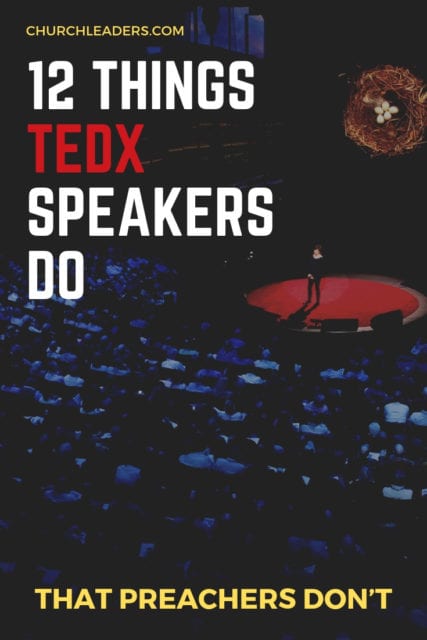Ever seen a TEDx talk? TEDx speakers are pretty great. Here’s one I happen to enjoy, and have used in a couple of sermons.
I’ve wondered for a long time, “How in the world do each of these talks end up consistently blowing me away?”
So I did some research and found the TEDx-talk guidelines for TEDx speakers. Some of the advice was basic—but some of it was unexpected. Much of it, I think, is a welcome wake-up call to preachers who are communicating in a 21st-century, postmodern, post-Christian context. Obviously, some of this doesn’t fit with a preacher’s ethos—but much of it does.
That said, here are 12 things TEDx speakers do that preachers usually don’t:
1. Present one great idea.
“An idea isn’t just a story or a list of facts. A good idea takes evidence or observations and draws a larger conclusion.”
Of course, TEDx speakers often have multiple points, but they always have direction: They’re always moving forward to a set conclusion (and that’s all big-idea preaching is, for all the flack it gets).
They also suggest to the speaker: “Get your idea out as quickly as possible.”
2. Set a time limit.
“Shorter talks are not lesser talks. It may only take five minutes to make your point unforgettably.”
Ouch—yes, I often speak too long. Like Pascal in his letter, most of us preach long sermons because we don’t have time to prepare short ones—certainly not 20 minutes—but we could all stand to lose a few.
Here’s how they approach this: “Make a list of all the evidence you want to use. Think about items that your audience already knows about and the things you’ll need to convince them of. Order all of the items in your list based on what a person needs to know before they can understand the next point, and from least to most exciting. Now cut out everything you can without losing the integrity of your argument. You will most likely need to cut things out you think are important.”
3. Collaborate.
On the above suggestion: “Consider making this list with a trusted friend, someone who isn’t an expert in your field.”
During rehearsal stage, the guide recommends “listening to criticism.” Calvin made it a rule for pastors in his region to collaborate on their texts before preaching.
Personally, I wish we didn’t see the sermon prep as a lone-ranger event: Why not ask the perspectives of people who represent those who will be listening to this thing, believers and nonbelievers alike?
4. Put time into visuals.
“Note anything in your outline that is best expressed visually and plan accordingly in your script.”
In the section regarding the question, “What goes in my slides?” the guide states: “Images and photos: To help the audience remember a person, place or thing you mention, you might use images or photos. … Use as little text as possible—if your audience is reading, they are not listening. Avoid using bullet points. Consider putting different points on different slides.”
We might not have time every week to come up with captivating visuals, but check out some websites like prezi.com—you’d be surprised how quickly you can put together an amazing presentation.
5. Practice.
“Once you’re settled on your outline, start writing a script. Be concise, but write in a way that feels natural to you. Use present tense and strong, interesting verbs.”
After the script is finished, the guide implores: “Rehearse, rehearse rehearse! We can’t stress this enough. … If someone says you sound “over-rehearsed,” this actually means you sound stilted and unnatural.”
6. Stay away from notes.
“TED discourages long talks, podiums or readings.”
This isn’t for everybody—but it’s certainly worth noting that according to the best TEDx speakers in the world, notes are considered to be a thing of the past.



